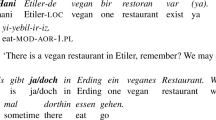Abstract
A well-known phenomenon in Swedish is that some adjectives are ‘defective’ in the sense that they are not possible in neuter gender. In previous explanations, it has usually been argued that the defective forms could be distinguished from non-defective forms by phonological and/or semantic criteria. Showing that such proposals cannot account for the data, I will argue that the defective paradigms are caused by a number of phonological constraints which block morphological productivity not only in defective forms, but also in many nondefective forms. Thus, contrary to what has traditionally been assumed, common patterns of vowel shortening and dental assimilation in Swedish adjective paradigms are not the result of productivity, but the result of a type of creative generalization where new formations require a sufficient degree of communicative need in order to be perceived as grammatical.
Similar content being viewed by others
References
Albright, A. (2003). A quantitative study of Spanish paradigm gaps. In G. Garding & M. Tsujimura (Eds.), WCCFL 22 proceedings, Somerville, MA (pp. 1–14). Cascadilla Press.
Baayen H., Lieber R. (1991) Productivity and English derivation: A corpus-based study. Linguistics 29: 801–843
Bauer L. (2001) Morphological productivity. Cambridge University Press, Cambridge
Berko J. (1958) The child’s acquisition of English morphology. Word 14: 150–177
Bybee J., Newman J. (1995) Are stem changes as natural as affixes? Linguistics 33: 633–654
Daland, R., Sims, A., & Pierrehumbert, J. (2007). Much ado about nothing: A social network model of Russian paradigmatic gaps. In Proceedings of the 45th annual meeting of the association for computational linguistics in Prague, Czech Republic, June 24th–29th, 2007.
Dressler W. (1985) On the predictiveness of natural morphology. Journal of Linguistics 21: 321–337
Dryer M. (2005a) Coding of nominal plurality. In: Haspelmath M., Dryer M., Gil D., Comrie B. (eds) The world atlas of language structures. Oxford University Press, Oxford, pp 138–141
Dryer M. (2005b) Position of tense-aspect affixes. In: Haspelmath M., Dryer M., Gil D., Comrie B. (eds) The world atlas of language structures. Oxford University Press, Oxford, pp 282–285
Eliasson, S. (1975). On the issue of directionality. In K.-H. Dahlstedt (Ed.), The nordic languages and modern linguistics (Vol. 2, pp. 421–445). Stockholm: Almqvist & Wiksell.
Halle M. (1973) Prolegomena to a theory of word formation. Linguistic Inquiry 4: 3–16
Hayes, B., Kirchner, R., Steriade, D. (eds) (2004) Phonetically based phonology. Cambridge University Press, Cambridge
Hellberg S. (1974) Graphonomic rules in phonology. Studies in the expression component of Swedish. Acta Universitatis Gothoburgensis, Göteborg
Hetzron R. (1975) Where the grammar fails. Language 51: 859–872
Iverson G. (1981) Rules, constraints, and paradigm lacunae. Glossa 15: 136–144
Johansson C. (1999) Learning what cannot be by failing expectations. Nordic Journal of Linguistics 22: 61–76
Löwenadler J. (2010) Relative acceptability of missing adjective forms in Swedish. In: Baerman M., Corbett G., Brown D. (eds) Defective paradigms. Missing forms and what they tell us. British Academy/Oxford University Press, Oxford, pp 69–83
McCarthy J. (2003) Comparative markedness. Theoretical Linguistics 29: 1–51
McCarthy, J., & Wolf, M. (2005). Less than zero: Correspondence and the null output. Ms, Rutgers Optimality Archive.
Orgun C.O., Sprouse R. (1999) From MParse to control: Deriving ungrammaticality. Phonology 16: 191–224
Pettersson T. (1990) Varför barnet inte kan vara latt. In: Andersson E., Sundman M. (eds) Svenskans beskrivning 17. Åbo den 18-19 maj 1989. Åbo Academy Press, Åbo, pp 293–302
Plag I. (1999) Morphological productivity. Structural constraints in English derivation. Mouton de Gruyter, Berlin
Prince, A., & Smolensky, P. (1993). Optimality theory. Ms, Rutgers University.
Sims, A. (in press). Avoidance strategies, periphrasis and paradigmatic competition in modern Greek. In J. Blevins, & F. Ackerman (Eds,), Periphrasis and paradigms. Stanford: CSLI Publications.
Steriade D. (2008) The phonology of perceptibility effects: The P-map and its consequences for constraint organization. In: Hanson K., Inkelas S. (eds) The nature of the word: Studies in honor of Paul Kiparsky. MIT Press, Cambridge, MA, pp 151–180
Teleman U., Hellberg S., Andersson E. (1999) Svenska Akademiens Grammatik, Part 2. Svenska Akademien, Stockholm
van Marle, J. (1985). On the paradigmatic dimension of morphological creativity. Ph.D. dissertation, University of Utrecht.
Author information
Authors and Affiliations
Corresponding author
Rights and permissions
About this article
Cite this article
Löwenadler, J. Restrictions on productivity: defectiveness in Swedish adjective paradigms. Morphology 20, 71–107 (2010). https://doi.org/10.1007/s11525-009-9145-6
Received:
Accepted:
Published:
Issue Date:
DOI: https://doi.org/10.1007/s11525-009-9145-6




